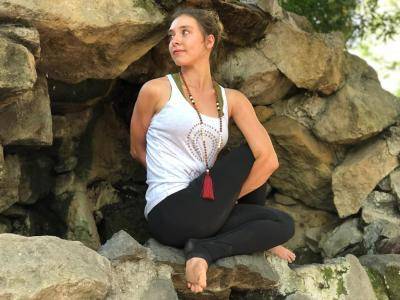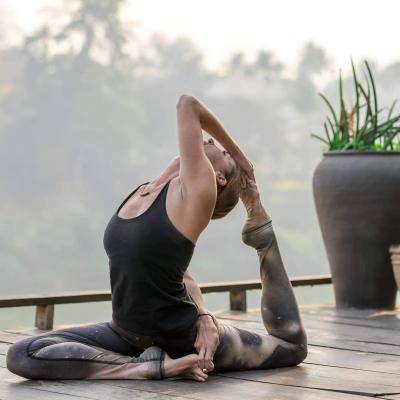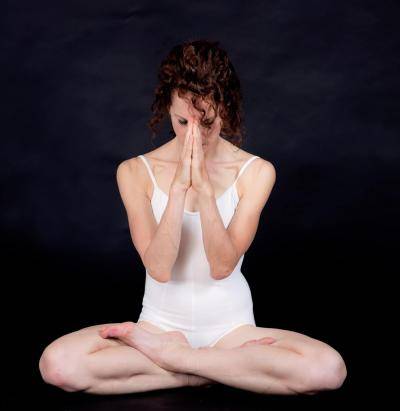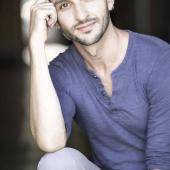According to Yoga Journal, the Yoga Sutra, “widely regarded as the authoritative text on yoga”, was written at least 1700 years ago. This predates almost all codified movement practices still used today. Needless to say, yoga has survived a lot. It has also helped me survive the tumultuousness of a career in dance. In honor of International Day of Yoga, I recently reached out to 5 dancers/yogis to weigh in on the relationship between dance and this ancient practice.
“Overall, I think yoga has made my dancing more enjoyable.” Allison Gomes trained in ballet most of her life and majored in dance at the University of California, Irvine. She has also been teaching yoga for seven and a half years, most recently throughout Southeast Asia. While Allison considers herself retired from dance, she also believes her expression of dance has improved:
“I’m certain that if someone were to watch me at the barre they would think I was at the peak of my [dance] career because I still perform.” This ability to dance joyfully in class, she says, comes directly from yoga’s philosophy of honoring one’s body.
“My dance practice feels like work, a deep calling, freedom and passion. Yoga feels like self love - vitamins and minerals for the soul and mind.” - Roya Carreras
While Allison had used yoga as exercise for many years, it wasn’t until she experienced a personal tragedy that she adopted the 8 limbed system of the Yoga Sutra. “I then made an entire lifestyle out of yoga” she says.
Through this yogic lifestyle and the 8 limbs, as described in Yoga Journal*, I continue to outline Allison’s journey, along with four other yoga practicing dancers, to explore the dancer’s relationship to yoga.
*Note that the 8 limbs here are being used as an introductory and organizational tool and the author acknowledges his expertise is surface level at best.
Limb 1 - Yama
Yoga Journal translates Yama as “the way we conduct ourselves in our life.” Lindsay Janisse, who dances on Broadway and has been teaching yoga since 2014, acknowledges that, like Allison, she first began the practice for the physical exercise but continued for her mental wellness. Her life’s intention is now led by the questions: “How do I want to live?” and “Who do I want to be?”
In dance - especially classic Western styles - the way we conduct ourselves is highly prescribed. There’s a specific etiquette and dress code and the movements are choreographed with a “right” and “wrong” way to execute them.
Allison believes this style of teaching is what first attracted her to Bikram as it felt similar to her experience in ballet class. She recalls: “Stare at your body in a mirror in a skimpy outfit and get screamed at.” Now, her integration of the 8 limbed system has given her permission to conduct herself, and her classes, in a more loving way.
Nancy Dobbs-Owen, a Los Angeles-based dancer, choreographer, and dance and yoga teacher, recounts a similar experience: “I began [practicing yoga] while dancing with the National Tour of Phantom of the Opera as a way to stay sane and heal my body and soul from both physical work and emotional abuse.” Nancy, who has now also been teaching yoga for 4 years, chooses to make dance work at the intersection of arts and activism. Her award-winning dance film Too Many Bodies advocates for common sense gun reform, for example.

All of this speaks to this author’s favorite tenant of Yama: Ahimsa (or Nonviolence). As Chasity Ramsey, a Los Angeles based freelance dancer and yoga instructor puts it, “Yoga is a healing art-form […] The yogic world is not as competitive as the dance world, which is very refreshing.”
Limb 2 - Niyama
Niyama speaks to self-discipline, which dancers know all too well. Chasity, who began dancing at age 4, exemplifies this through her own journey with dance, which included attending a performing arts highschool, annual summer intensives, and earning her BFA from the rigorous conservatory program of AMDA (American Musical and Dramatic Academy) in Hollywood. This type of discipline becomes ingrained in everything a dancer takes on. Chasity, who began teaching yoga 2 years ago, says “currently, I practice yoga and meditation everyday.”
Allison has noticed that this positively shapes a dancer’s yoga experience: “Because of their discipline and training, dancers have a respect and an honor for the totality of the [yoga] practice […] dancers treat Asana practice with care.”
Limb 3 - Asana
Asana is what most people think of as yoga - the postures and positions of the body - but the Yoga Sutra utilizes the physical practice to recognize that “the body is a temple of spirit.” All five dancers credit their practice with keeping their dancing body healthy, acknowledging the physical benefits including cross training, enhanced physical awareness, and injury prevention.
However, Allison also warns: “Dancers be cautious. If you want to learn yoga Asana, take the care to really learn it [...] The proper way to do the postures is rarely what you would assume from looking at the shapes with a dancer’s eye.” This comes from Allison not only as a yoga instructor, but as a practitioner using yoga as a means to balance and recover from past dance injuries. As she explains:
“In yoga, you learn about all of the systems of the body, physical and energetic. You learn about how postures can affect all of the internal systems and how they can release emotions from the body and effect personality traits. A lot of people when starting to work deeply in the body for the first time, release certain trauma they have been holding internally […] Yoga has an entire philosophical support system for these effects.”
As Lindsay puts it, “discovering yoga has created a new sacred space for me to live in.”

Limb 4 - Pranayama
In other words, the physical practice of yoga is just a gateway to its full benefits. Yoga’s attention to breathing, for example, has been a recognized benefit to Roya Carreras’ dancing. This brings us to the fourth limb, Pranayama, which is the practice of breath control. Roya, a New York-based ballet teacher and contemporary dancer/choreographer has been practicing yoga for 10 years and says she’s noticed breathwork has improved her work as an improvisational performer. She notes:
“[Yoga] has affected my relationship to myself and my breath, which has made me an overall healthier person. I’m sure (I hope) that shows up in my dance practice.”
Nancy also identified how an increased connection to breathing has improved her dance practice: “I have become much more aware of where I place my breath in dance, particularly in turns and adagio [...] The breathing in yoga is so methodical and choreographed and I find that the more that I am able to apply that to dance (especially in auditions and high pressure situations) the more successful I am.”
Lindsay agrees, saying “breath is your anchor. It is what guides you through your practice.” As a theater performer, she’s also recognized the benefits of using breath to connect to and express emotion.
A focus on breath is the first step toward finding our mind-body connection. As Chasity explains: “the mind is a reaction of the breath and the body is a reaction of the mind.” She says “one of the biggest thrills with teaching yoga is teaching people how to breathe.”
Limb 5 - Pratyahara
“It is during this stage, [pratyahara], that we make the conscious effort to draw our awareness away from the external world and outside stimuli.” Allison recalls her early ballet training was “based on how it was supposed to look. Make this shape. Look in the mirror and recreate this position.” She says yoga, rather, is “a very personal practice, working with your body and your body alone. You are learning how, when, and why to move the body - or not move the body - from the inside out, and from an intellectual level.”
Nancy agrees, saying: “the focus on process rather than product, the lack of mirrors, the inside out approach and the emphasis on being where you are in the moment is profound and healing.”

Limb 6 - Dharana
Dharana is about concentration on a singular point, concept, or idea. Each limb of yoga is designed to prepare us for the next, so now that we’ve taken time to understand our behavior, our body, our breath, and retracted from outside distractions, we are ready to focus our mind and steady our thoughts.
“I think the biggest influence my yoga practice has had on my dance practice is awareness” Lindsay says. Her practice has helped her “fully engage in the present moment.” This is particularly important for Lindsay who performs as a vacation swing for Wicked and Rock of Ages, meaning she may not perform a particular role or track for 6 months before needing to be ready to go on stage. Concentration is paramount in this instance.
For Roya, mindfulness is “never ending work” and she’s implemented a practice of concentration into her teaching. She even utilizes yogic practices with her classical ballet students to “impact the youth in a positive way.”
An interesting commonality Roya shares with Nancy and Allison is that they all began their dancing training in ballet above the age of 10 - relatively late, especially for women. I imagine learning such an aesthetically specific dance form during an age when bodies are rapidly changing would be fraught with challenges, beyond just the physical rigor. Both Allison and Nancy also spoke to emotional abuse in the ballet studio, but it’s clear that yoga has given them each a healthier approach to dancing which is in large part due to their shift in focus. It’s encouraging to hear that dancers have been able to implement the benefits they’ve received from yoga into their dance classes, thus contributing to the development of our beloved social art form.

Limb 7 - Dhyana
Dhyana is what we know as meditation. Yoga Journal explains “where Dharana practices one-pointed attention, Dhyana is ultimately a state of being keenly aware without focus.” When it comes to this limb, Chastity notices “a lot of people are intimidated by meditation because they are intimidated by their own thoughts and feelings that come up. Meditation is not about quieting the mind, that's a common misconception.”
Allison relates this to the needs of a dancer, acknowledging that “the mind is a portal to deep subconscious places within ourselves.” In reflecting on the physical rigor of her own dance training with her now deep understanding of mind-body connection, she’s taken aback that dance is taught without a foundation of philosophical support. She believes dancers “absolutely need some sort of mindfulness practice to deal with the intensity of what they are doing.”
Linsday, for example, utilized her practice when on tour: “Wherever I was, I could simply roll out my mat and be home.” By returning to her breath, body, and mind, she could detach herself from the stressors, negative emotions, and discomforts associated with tour life, allowing her to perform at her best.
Limb 8 - Samadhi
It is this practice of non-attachment that’s said to help lead us to the final limb, Samadhi, which is described as “a state of ecstasy”. A practice of non-attachment makes Allison believe her retirement from performing was less distressing than it might have been without yoga. “Yoga in a way led me away from dance and freed me from even the concept of having an ‘identity as a dancer’ […] All the work you do as a yogi is to break free from the illusion that you have any solid permanent external identity.”
“And [yoga] has given me a future.” Lindsay adds on. “it has made me realize and acknowledge that there is more for me. The passion I have for yoga has equaled that of my passion for dance, and that has been quite a discovery!”
So is a practice in yoga a replacement for dance?
Absolutely not. Both Allison and Lindsay still actively include dance in their daily lives. Roya also distinguishes the differences in each practice: “My dance practice feels like work, a deep calling, freedom and passion. Yoga feels like self love - vitamins and minerals for the soul and mind.”
"This ability to dance joyfully in class [...] comes directly from yoga’s philosophy of honoring one’s body" - Allison Gomes
As Nancy puts it, as a professional dancer “it is both your passion and your job, your life force and your survival. Yoga is a respite from that; a physical practice that supports but does not have the weight of expectation.” With that said, she does find opportunities to combine her dance and yoga practices. “I apply yoga ideas and concepts to dance in a completely symbiotic way. It is, at this point, completely integrated.”
Chasity takes it a step further, identifying herself now as a movement artist. “Yoga has given me a clean slate with my dance career. Dancing should never make us feel like we have to look a certain way, dance a certain way or be a certain way.” She believes “dance is the universal language of our soul. We should dance because it feels good to move our bodies, because it makes our hearts smile.”
Now doesn’t that sound like a state of ecstasy?



